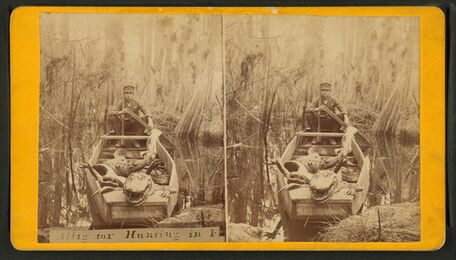Biology:Alligator hunting
Alligator hunting is the capture and killing of gators. With the appropriate licenses and tags, the American alligator can legally be hunted in the Southeastern United States. The states of Florida, Georgia, Alabama, Arkansas, Mississippi, Louisiana, North Carolina, South Carolina, and Texas all distribute alligator hunting licenses.[1][2][3][4][5]
Methods
There is no single method of alligator hunting. Depending on the circumstances, hunters commonly use a combination of the following:[6]
- hook and line
- bow and arrow
- gig and snare
- firearm
The use of a hook and line is the most common method. It involves securing a sturdy hook and line to a tree or pole in the ground. The hook is commonly baited with fish or chicken quarter. After the bait is taken, the hunter returns to draw in and dispatch the gator.[7] Allowed methods of hunting vary by state, in South Carolina an alligator must be captured before being killed with either a handgun or bangstick.[8]
A bangstick is a specialized underwater firearm fired only when in direct contact with the target.
History
Historically, unregulated hunting has led to dramatic decreases in alligator populations. In 1973 the American alligator was listed as endangered under the Endangered Species Act of 1973.[6][9] The American alligator was listed as an endangered species in 1967 under a law that was a precursor to the Endangered Species Act of 1973. Since the species' recovery, alligator hunting programs have been established in the majority of U.S. States in the alligator's habitat range.[10]
Products
The main products of alligator hunting are alligator meat and skin. Alligator skins have been harvested since the 1800s. Alligator skin was used in the manufacture of boots, belts, and saddles. In the early 1900s some states began the commercial tanning of alligator skin.[11] The increased popularity of alligator leather lead to the rise of alligator farming, now a $60 million industry. Following the global economic recession of 2008, demand for wild alligator skins declined dramatically. In the state of Louisiana the number of reported skins dropped from 35,625 to 9,139 in one year.[12]
References
- ↑ "MDWFP Alligator Program". http://mdwfp.com/wildlife-hunting/alligator-program.aspx.
- ↑ "Georgia Alligator Hunting Program". http://www.georgiawildlife.com/node/610.
- ↑ "Florida Alligator Hunting Program". http://myfwc.com/wildlifehabitats/managed/alligator/harvest/.
- ↑ "Alabama Alligator Hunting Program". http://www.outdooralabama.com/alligator-hunting-season-alabama.
- ↑ "Changes in Regulations for 2018-2019". http://ncwildlife.org/Blog/changes-in-regulations-for-2018-2019.
- ↑ 6.0 6.1 "Alligators in Texas". Texas Parks and Wildlife. http://tpwd.texas.gov/publications/pwdpubs/media/pwd_bk_w7000_1011.pdf. Retrieved 13 February 2015.
- ↑ "Alligator Hunting". Louisiana Department of Wildlife and Fisheries. http://www.wlf.louisiana.gov/wildlife/alligator-hunting. Retrieved 13 February 2015.
- ↑ "South Carolina Alligator Hunting Guide (2009)". SC Department of Natural Resources. http://www.dnr.sc.gov/wildlife/alligator/pdf/gatorhuntguide.pdf. Retrieved 13 March 2015.
- ↑ "American Alligator Alligator mississippiensis". U.S. Fish & Wildlife Service. http://www.fws.gov/endangered/esa-library/pdf/alligator.pdf. Retrieved 13 February 2015.
- ↑ "Alligator Hunting Guides and Outfitters Trips and Guided Hunts". Hunting Trips R Us. http://www.huntingtripsrus.com/alligator-hunting.html.
- ↑ "General Alligator Information". http://www.wlf.louisiana.gov/general-alligator-information. Retrieved 27 February 2015.
- ↑ "Numbers of Alligator Skins Taken and Their Uses During 1 800 - 20 1 0 in Louisiana". http://www.wlf.louisiana.gov/sites/default/files/pdf/page/33674-historical-data/historicalligatorskinsuses-1800-2010.pdf. Retrieved 27 February 2015.


